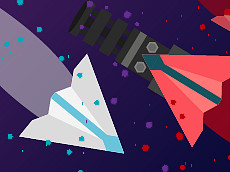NEW GAMES
POPULAR GAMES
YOU MAY LIKE
The Rise and Evolution of HTML5 and Online Games
Introduction
The gaming industry has undergone a remarkable transformation over the past few decades, evolving from bulky arcade machines to sophisticated console systems and, more recently, to the expansive world of online and browser-based games. Among these, HTML5 games have emerged as a cornerstone of modern online gaming, offering accessibility, versatility, and innovation. This article explores the rise of HTML5 games, their impact on the online gaming landscape, and the broader trends shaping the future of digital entertainment. Spanning approximately 2000 words, this comprehensive analysis delves into the technology, market dynamics, and cultural significance of HTML5 and online games.
The Genesis of HTML5 Games
HTML5, the fifth iteration of the HyperText Markup Language, was standardized in 2014 by the World Wide Web Consortium (W3C). Unlike its predecessors, HTML5 was designed with multimedia and interactivity in mind, introducing features like the <canvas> element, WebGL for 3D rendering, and native support for audio and video. These advancements eliminated the need for third-party plugins like Adobe Flash, which had long been the backbone of browser-based games but was plagued by security issues and performance limitations.
The introduction of HTML5 marked a turning point for online gaming. Developers could now create rich, interactive experiences that ran directly in web browsers across devices—desktops, smartphones, tablets, and even smart TVs—without requiring users to download dedicated software. This cross-platform compatibility, coupled with the ubiquity of web browsers, democratized game development and distribution, enabling small studios and independent developers to compete with industry giants.
Technical Foundations of HTML5 Games
HTML5 games leverage a combination of technologies to deliver engaging experiences:
HTML5 Canvas and WebGL: The <canvas> element allows developers to render 2D graphics, while WebGL enables hardware-accelerated 3D graphics, making it possible to create visually stunning games within the browser.
JavaScript: As the primary scripting language for web development, JavaScript powers the logic and interactivity of HTML5 games. Libraries like Phaser, Three.js, and PixiJS simplify game development by providing pre-built tools for physics, rendering, and animations.
CSS3: Cascading Style Sheets enhance the visual design of games, enabling smooth transitions, animations, and responsive layouts that adapt to different screen sizes.
Web Audio API: This API allows developers to integrate high-quality sound effects and music, enhancing the immersive quality of games.
WebSockets and WebRTC: These technologies enable real-time multiplayer functionality, allowing players to connect and compete seamlessly across the globe.
The lightweight nature of HTML5 games ensures low storage requirements and fast load times, making them ideal for casual gaming on mobile devices with limited resources.
The Appeal of HTML5 Games
HTML5 games have gained widespread popularity due to several key advantages:
Accessibility: HTML5 games require only a web browser, making them accessible to billions of users worldwide. No installation is needed, reducing barriers to entry for casual gamers.
Cross-Platform Compatibility: Games built with HTML5 run on virtually any device with a modern browser, from iPhones to Android devices to PCs, ensuring a broad audience reach.
Cost-Effectiveness: For developers, HTML5 eliminates the need to create separate versions of a game for different platforms, reducing development costs. For players, most HTML5 games are free-to-play, often monetized through ads or in-game purchases.
Instant Updates: Unlike traditional games that require manual updates, HTML5 games are hosted on servers, allowing developers to roll out patches, new levels, or features instantly.
Social Integration: Many HTML5 games integrate with social media platforms, enabling players to share scores, invite friends, or compete on leaderboards, fostering a sense of community.
These factors have made HTML5 games a staple of casual gaming, with titles like Agar.io, Slither.io, and 2048 achieving viral success.
The Broader Landscape of Online Games
While HTML5 games represent a significant segment of online gaming, the broader ecosystem encompasses a wide range of genres and platforms, including:
Massively Multiplayer Online Games (MMOs): Titles like World of Warcraft and Final Fantasy XIV offer expansive virtual worlds where thousands of players interact in real-time.
Mobile Games: The rise of smartphones has fueled the growth of mobile gaming, with games like Candy Crush Saga and Among Us dominating app stores.
Cloud Gaming: Services like Google Stadia, NVIDIA GeForce Now, and Xbox Cloud Gaming stream high-end games to devices over the internet, reducing the need for powerful hardware.
Social and Casual Games: Platforms like Facebook and Roblox host games that emphasize social interaction and user-generated content, appealing to diverse audiences.
Esports and Competitive Gaming: Games like League of Legends, Dota 2, and Fortnite have turned online gaming into a professional sport, with multimillion-dollar tournaments and global fanbases.
HTML5 games often overlap with these categories, particularly in the casual and social gaming sectors, but their browser-based nature sets them apart from native apps or console titles.
Market Trends and Monetization
The global gaming market was valued at approximately $200 billion in 2023, with online and mobile games accounting for a significant share. HTML5 games, while often free-to-play, contribute to this revenue through various monetization strategies:
In-Game Advertising: Banner ads, interstitial ads, and rewarded video ads generate revenue while keeping games free for players.
In-App Purchases: Players can buy cosmetic items, power-ups, or premium features to enhance their experience.
Sponsorships and Branded Content: Some HTML5 games are developed as promotional tools for brands, integrating products or logos into the gameplay.
Subscription Models: Platforms like Poki and CrazyGames offer ad-free experiences or exclusive content for a monthly fee.
The low development costs of HTML5 games make them an attractive option for indie developers, who can publish games on portals like Kongregate, Newgrounds, or itch.io without significant upfront investment. Meanwhile, larger companies like Miniclip and Zynga leverage HTML5 to deliver polished titles to millions of players.
Cultural and Social Impact
Online games, including HTML5 titles, have become a cultural phenomenon, shaping how people interact, entertain themselves, and even learn. Key impacts include:
Community Building: Online games foster communities where players form friendships, collaborate on challenges, or compete in tournaments. Discord servers, Reddit forums, and Twitch streams amplify these connections.
Educational Potential: HTML5 games are increasingly used in education, with titles like Mathletics and TypingClub gamifying learning for students. Their browser-based nature makes them easy to deploy in classrooms.
Inclusivity: The accessibility of HTML5 games ensures that people of all ages, backgrounds, and technical skill levels can participate, broadening the gaming demographic.
Mental Health and Well-Being: Casual HTML5 games, such as puzzles or relaxation-focused titles like Flow Free, provide stress relief and cognitive stimulation for players.
However, online gaming also faces challenges, including concerns about addiction, toxic behavior in multiplayer environments, and privacy issues related to data collection. Developers and platforms must address these issues to maintain trust and ensure a positive experience.
Challenges in HTML5 Game Development
Despite their advantages, HTML5 games face several hurdles:
Performance Limitations: While WebGL and modern browsers have improved performance, HTML5 games still lag behind native apps in terms of graphics quality and processing power, particularly for complex 3D titles.
Browser Compatibility: Variations in browser implementations can lead to inconsistent performance or bugs, requiring developers to test games across multiple browsers.
Monetization Trade-Offs: Heavy reliance on ads can detract from the user experience, while aggressive in-app purchases may alienate players.
Discoverability: With thousands of HTML5 games available, standing out on crowded platforms requires effective marketing and high-quality design.
Advancements in browser technology and development tools are gradually addressing these challenges, but developers must remain agile to stay competitive.
The Future of HTML5 and Online Games
The future of HTML5 and online gaming is bright, driven by technological innovation and evolving consumer preferences. Key trends to watch include:
Progressive Web Apps (PWAs): PWAs combine the accessibility of HTML5 games with the functionality of native apps, allowing users to install games on their devices without app stores. This hybrid approach enhances offline play and push notifications.
WebAssembly (Wasm): WebAssembly enables near-native performance for browser-based games, allowing developers to port high-performance titles from languages like C++ or Rust to the web.
Augmented Reality (AR) and Virtual Reality (VR): WebXR, an API for AR and VR in browsers, is opening new possibilities for immersive HTML5 games that run on devices like Oculus Quest or smartphones.
Artificial Intelligence (AI): AI-driven NPCs, procedural content generation, and personalized gaming experiences are becoming more prevalent, enhancing the depth and replayability of online games.
Blockchain and NFTs: Some online games are experimenting with blockchain technology and non-fungible tokens (NFTs) to create decentralized economies and player-owned assets, though their long-term viability remains uncertain.
5G and Edge Computing: The rollout of 5G networks and edge computing will reduce latency and improve connectivity, enabling more seamless multiplayer experiences and cloud-based gaming.
These advancements suggest that HTML5 games will continue to evolve, blurring the lines between browser-based and traditional gaming platforms.
Case Studies: Successful HTML5 Games
To illustrate the potential of HTML5 games, consider the following examples:
Agar.io: Launched in 2015, this simple multiplayer game became a viral hit, attracting millions of players with its addictive "eat-or-be-eaten" mechanic. Its minimalist design and browser-based accessibility made it a global phenomenon.
Slither.io: Inspired by the classic Snake, this 2016 title combined HTML5’s multiplayer capabilities with smooth, responsive gameplay, generating significant ad revenue for its creator.
Krunker.io: A fast-paced first-person shooter, Krunker leverages WebGL to deliver console-like graphics in the browser, appealing to competitive gamers and esports enthusiasts.
These games demonstrate how HTML5 can deliver engaging, scalable experiences with minimal resources, inspiring a new generation of developers.
Conclusion
HTML5 games have revolutionized online gaming by making it more accessible, inclusive, and innovative. Their browser-based nature, combined with powerful web technologies, has enabled developers to create diverse experiences that rival traditional games in quality and engagement. As part of the broader online gaming ecosystem, HTML5 games are poised for continued growth, driven by advancements in web standards, connectivity, and player expectations.
From casual puzzles to competitive shooters, HTML5 games cater to a global audience, fostering communities and shaping digital culture. While challenges like performance and monetization persist, the future holds immense potential, with technologies like WebAssembly, WebXR, and AI set to redefine what’s possible in the browser. As we move toward a more connected and interactive digital world, HTML5 and online games will remain at the forefront, proving that great gaming experiences can be just a click away.






















































































































































































































